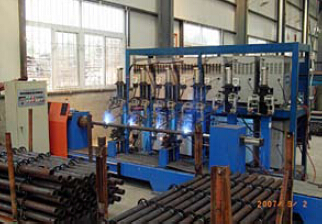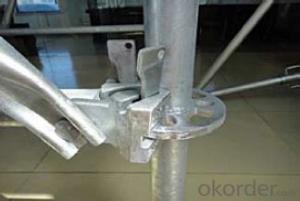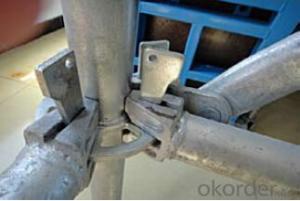Ring-Lock Scaffolding Accessories for scaffolding system
- Loading Port:
- Tianjin
- Payment Terms:
- TT OR LC
- Min Order Qty:
- 50 m²
- Supply Capability:
- 1000 m²/month
OKorder Service Pledge
Quality Product, Order Online Tracking, Timely Delivery
OKorder Financial Service
Credit Rating, Credit Services, Credit Purchasing
You Might Also Like
Ring-lock Scaffolding
A support system for construction, ownsadvantages of both cup-lock scaffolding andshoring tower.
It is in the development direction of new typescaffolding.
It is widely used in buildings, bridges, tunnels etc..
Characteristics:
◆ Easy to storage and transportation
◆ High degree of standardization
◆ Easy and quick erection
◆ Excellent stability and bearing capacity


- Q:How does steel formwork affect the overall safety of construction workers?
- Steel formwork can greatly enhance the overall safety of construction workers. Firstly, steel formwork is known for its durability and strength, which makes it highly resistant to damage or collapse during the construction process. This ensures that workers are protected from potential accidents caused by the formwork failing or collapsing. Additionally, steel formwork is designed to be structurally stable, providing a secure and stable platform for workers to carry out their tasks. This stability reduces the risk of slips, trips, and falls, which are among the most common causes of accidents in construction sites. With a stable formwork system, workers can confidently move around and work at heights without the fear of the platform giving way. Furthermore, steel formwork is designed to be modular and easily assembled, allowing for quick and efficient construction processes. This reduces the time workers spend on the construction site, minimizing their exposure to potential hazards and risks. By reducing the duration of the project, steel formwork also decreases the overall fatigue and stress levels of workers, leading to increased alertness and improved safety. Another safety advantage of steel formwork is its resistance to fire. Steel does not burn or contribute to the spread of fire, which adds an extra layer of protection for construction workers in case of fire accidents on-site. This feature significantly reduces the risk of injuries or fatalities due to fire incidents, ensuring the safety of workers. Overall, the use of steel formwork in construction significantly enhances the safety of workers. Its durability, stability, quick assembly, and fire resistance properties all contribute to creating a safer working environment, reducing the likelihood of accidents and injuries. By investing in steel formwork, construction companies prioritize the well-being of their workers and promote a culture of safety on the construction site.
- Q:Can steel formwork be customized to meet specific project requirements?
- Yes, steel formwork can be customized to meet specific project requirements. Steel formwork is highly versatile and can be easily modified and fabricated to fit any shape or size needed for a particular project. This adaptability allows for greater flexibility in construction, ensuring that the formwork meets the precise specifications and dimensions required for the project.
- Q:How does steel formwork affect the overall aesthetics of a construction project?
- Steel formwork can greatly enhance the overall aesthetics of a construction project. Its sleek and clean appearance creates a modern and professional look, adding a touch of sophistication to the structure. Moreover, steel formwork allows for precise and accurate shaping of concrete, resulting in smooth surfaces and sharp edges that contribute to a visually appealing end product. Additionally, steel formwork offers versatility in design, enabling complex architectural elements and patterns, ultimately enhancing the overall aesthetic appeal of the construction project.
- Q:Can steel formwork be used for precast concrete walls?
- Yes, steel formwork can be used for precast concrete walls. Steel formwork is a commonly used material in the construction industry due to its strength, durability, and reusability. It provides a solid and stable framework for pouring and shaping concrete during the precast concrete wall manufacturing process. Steel formwork is suitable for precast concrete walls because it can withstand the pressure exerted by the wet concrete without bending or deforming. It ensures that the concrete is poured and set in the desired shape and dimensions. Moreover, steel formwork can be easily assembled and disassembled, allowing for efficient and cost-effective production of precast concrete walls. Another advantage of using steel formwork for precast concrete walls is its ability to produce smooth finishes. The steel panels or molds can be designed to create different textures and patterns on the finished wall surface. This flexibility allows for more design options and aesthetic appeal in the final product. Furthermore, steel formwork can be reused multiple times, making it an environmentally friendly and cost-effective choice for precast concrete wall production. The durability of steel ensures that it can withstand the repetitive stresses of the manufacturing process without significant wear and tear. In summary, steel formwork is a suitable material for precast concrete walls due to its strength, durability, reusability, and ability to produce smooth finishes. It provides a solid framework for shaping and pouring concrete, allowing for efficient and cost-effective production of precast concrete walls.
- Q:Are there any safety precautions to consider when using steel formwork?
- Yes, there are several safety precautions to consider when using steel formwork. Firstly, proper training should be provided to all workers involved in the assembly, dismantling, and use of steel formwork. Workers should be aware of the potential hazards, such as falling objects, and should use appropriate personal protective equipment (PPE) such as hard hats and safety harnesses. Additionally, regular inspections of the formwork should be conducted to ensure its structural integrity and stability. Adequate bracing and shoring should be in place to prevent collapse or movement of the formwork during concrete pouring. It is also important to follow manufacturer's guidelines and recommendations for the safe use of steel formwork. Overall, prioritizing safety measures and adhering to industry standards is crucial to minimize the risk of accidents or injuries when using steel formwork.
- Q:How does steel formwork accommodate for different concrete curing temperatures?
- Steel formwork is a versatile and reliable option for accommodating different concrete curing temperatures. The main advantage of steel formwork is its high thermal conductivity, allowing it to effectively dissipate heat from the curing concrete. This property enables the steel formwork to regulate the temperature of the concrete during the curing process. In situations where the concrete curing temperature needs to be controlled, steel formwork can be equipped with additional features to accommodate these requirements. For instance, insulation materials can be applied to the steel formwork to minimize heat loss or gain, ensuring a steady and consistent curing temperature. This is particularly useful in extreme weather conditions, where the ambient temperature can significantly impact the curing process. Moreover, steel formwork can also be used in conjunction with heating or cooling systems to further regulate the concrete curing temperature. For example, in cold weather conditions, heating elements can be integrated into the steel formwork to maintain a favorable temperature for proper curing. Similarly, in hot weather conditions, cooling systems can be employed to prevent excessive heat from affecting the curing process. Additionally, steel formwork offers excellent strength and durability, which is crucial for accommodating different concrete curing temperatures. The robust nature of steel formwork allows it to withstand the pressure and stresses exerted by the curing concrete, regardless of the temperature. This ensures that the formwork remains intact and stable throughout the curing process, preventing any deformations or failures that may compromise the quality of the concrete structure. Overall, steel formwork is an ideal choice for accommodating different concrete curing temperatures due to its high thermal conductivity, adaptability to insulation materials, and compatibility with heating or cooling systems. Its strength and durability further enhance its ability to withstand the challenges posed by varying curing temperatures, ensuring the successful and optimal curing of the concrete.
- Q:How does steel formwork affect the overall durability of the structure?
- Steel formwork can have a significant impact on the overall durability of a structure. Steel is known for its strength and durability, making it an ideal material for formwork. One of the key ways in which steel formwork affects the durability of a structure is through its ability to withstand the forces and pressures exerted during the construction process. Steel formwork provides excellent support and stability to the concrete during pouring and curing, ensuring that it maintains its shape and strength. This helps to prevent any deformation or cracking that could compromise the overall durability of the structure. Additionally, steel formwork is highly resistant to wear and tear, which is crucial for projects that involve multiple concrete pours. Unlike other types of formwork such as timber, steel formwork does not warp, shrink, or expand due to moisture or temperature changes. This allows for multiple uses and reuses, reducing the need for frequent replacements and ultimately increasing the lifespan of the structure. Furthermore, steel formwork offers superior protection against environmental factors such as corrosion and fire. Steel is inherently resistant to rust and decay, which can significantly extend the lifespan of the formwork and consequently the structure itself. Moreover, steel formwork provides higher fire resistance compared to other materials, reducing the risk of structural damage and enhancing the overall durability of the building. In summary, steel formwork positively affects the overall durability of a structure by providing excellent support, stability, and protection against various forces and environmental factors. Its strength, resistance to wear and tear, and superior properties make it a reliable choice for construction projects, ensuring the longevity and durability of the structure.
- Q:What are the different sizes and dimensions of steel formwork panels?
- Different construction needs are catered to by steel formwork panels that come in various sizes and dimensions. The manufacturer and specific project requirements determine the sizes and dimensions of steel formwork panels, although common sizes and dimensions are widely available in the market. Typically, the standard dimensions of steel formwork panels range from 1.2 meters to 2.4 meters in length and 0.6 meters to 1.2 meters in width. These standard sizes are designed for easy handling and transportation on construction sites. Additionally, the thickness of steel formwork panels can vary from 3 millimeters to 6 millimeters, depending on the required load-bearing capacity. Custom sizes can also be manufactured to meet specific project needs, which may be larger or smaller than the standard dimensions depending on the complexity and scale of the construction project. Due to the durability and strength of the material, steel formwork panels are relatively heavy. The weight of a steel formwork panel can range from 30 kilograms to 50 kilograms, depending on its size and thickness. In conclusion, the sizes and dimensions of steel formwork panels can vary to meet different construction requirements. It is important to consult with a supplier or manufacturer to determine the most suitable size and dimension for a specific project.
- Q:Can steel formwork be used for tunnel portals?
- Yes, steel formwork can be used for tunnel portals. Steel formwork is a versatile and durable option for constructing tunnel portals due to its strength and ability to withstand the forces and pressures exerted by the surrounding soil and rock. Steel formwork can be fabricated to any shape and size required for tunnel portals and can be easily assembled and disassembled, making it a practical choice for tunnel construction. Additionally, steel formwork provides a smooth surface finish, which is important for tunnel portals as it allows for efficient flow of traffic and reduces the risk of damage to vehicles. Overall, steel formwork is a suitable and commonly used method for constructing tunnel portals.
- Q:Can steel formwork be used in extreme weather conditions?
- Yes, steel formwork can be used in extreme weather conditions. Steel is a durable and resilient material that can withstand harsh weather elements such as extreme temperatures, heavy rain, strong winds, and even snow. It provides a stable and reliable support system for concrete construction projects, ensuring structural integrity regardless of the weather conditions.
1. Manufacturer Overview |
|
|---|---|
| Location | |
| Year Established | |
| Annual Output Value | |
| Main Markets | |
| Company Certifications | |
2. Manufacturer Certificates |
|
|---|---|
| a) Certification Name | |
| Range | |
| Reference | |
| Validity Period | |
3. Manufacturer Capability |
|
|---|---|
| a)Trade Capacity | |
| Nearest Port | |
| Export Percentage | |
| No.of Employees in Trade Department | |
| Language Spoken: | |
| b)Factory Information | |
| Factory Size: | |
| No. of Production Lines | |
| Contract Manufacturing | |
| Product Price Range | |
Send your message to us
Ring-Lock Scaffolding Accessories for scaffolding system
- Loading Port:
- Tianjin
- Payment Terms:
- TT OR LC
- Min Order Qty:
- 50 m²
- Supply Capability:
- 1000 m²/month
OKorder Service Pledge
Quality Product, Order Online Tracking, Timely Delivery
OKorder Financial Service
Credit Rating, Credit Services, Credit Purchasing
Similar products
New products
Hot products
Hot Searches
Related keywords























